When it comes to decorating small spaces like bathrooms, en-suites, and cloakrooms, creating an impact with the decor can be a challenge. While tiles and paint are popular choices, bathroom wallpaper can provide a quick and easy alternative to transform the look of a bathroom. In this article, we will explore various bathroom wallpaper ideas that can add instant color and impact to bathroom walls.
1. Go Bold with an Oversized Print
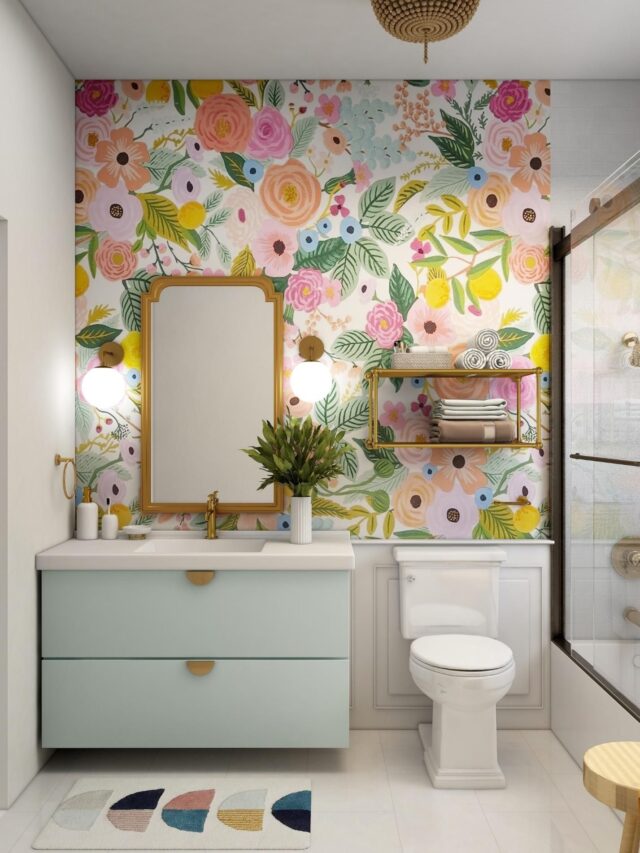
Specialist bathroom wallpaper designed to cope with steamy conditions can be a brilliant way to brighten up a small bathroom on a budget. Consider using contour wallpaper with a 3D effect that mimics the look of tiles, marble, or mosaic. This wallpaper can be hung easily and has a splash-proof and wipe-clean finish.
2. Find the Right Spot
Avoid applying wallpaper to areas that experience a lot of splashback, such as around a bath, shower, or sink. If you do choose to use wallpaper in these areas, consider pairing it with complimentary tiles for extra protection. Proper ventilation is essential to prevent peeling, so keep windows and doors open or use an extractor fan during application.
3. Pretty Up a Plain Scheme
Bathrooms often have cold, hard surfaces that can feel stark and clinical. Add warmth and soften the space by incorporating areas of color and pattern. Consider using patterned wallpaper above the basin to bring softness to plain white tiles and fittings. A delicate chinoiserie or floral design in a subtle colorway can make a big difference.
4. Pick a Print to Complement Tiles

Small spaces like bathrooms are ideal for going big and bold with wallpaper. Pair tiles with a bold wallpaper featuring a single accent color for an exciting design moment. Dark colors can work well in small spaces, especially when paired with glossy tiles, mirrors, and metallic accents to add extra sparkle.
5. Stretch Space with Stripes
Horizontal stripes can visually lengthen walls and make a small bathroom feel wider. Focus on just one wall and opt for simple bands of color that draw the eye along and stretch the space visually. In a low-ceilinged bathroom, vertical stripes can make walls appear taller and the ceiling higher.
6. Protect the Finish
To protect wallpaper from splashes in areas that may come into contact with water, such as around a basin, consider adding a clear acrylic or perspex splashback. Matching the wallpaper color to the flooring can help blur the edges of a room and create a sense of expansiveness.
7. Pair Panelling with a Print
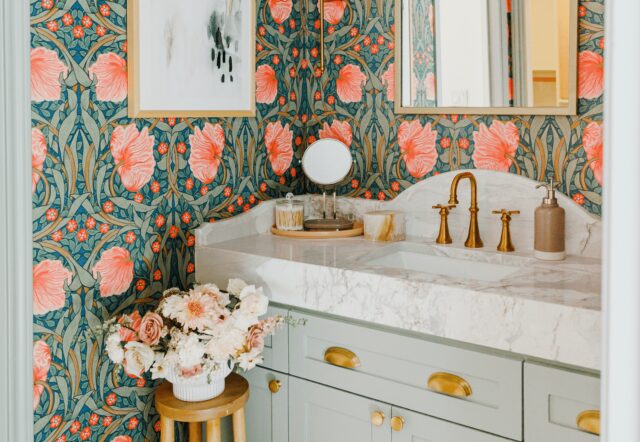
Instead of tiling the lower portion of the wall, consider using painted panelling as a stylish alternative. Color match the wallpaper with the painted panelling for a coordinated look. Choose a bold design and pick an accent color from within the wallpaper design to provide visual contrast.
8. Go with the Faux
Mimic the look of tiled walls with faux-tile wallpaper that is easier to put up and maintain. Look for “paste-the-wall” wallpapers, which are less messy and require no pre-soaking or sticky paste table.
9. Pick a Point of Focus
Use bold bathroom wallpaper to create a point of focus. Dedicate a surface area above the sink to showcase a captivating wallpaper design. Consider using a wallpaper design in a soft blue colorway to add a watery touch to the bathroom.
10. Protect Surfaces
Take care to protect the wallpaper surface in areas that may be exposed to water. Consider using a protective marbled splashback around points of water flow, such as the taps. Choose a transparent material that allows the wallpaper pattern to be visible while safeguarding it from water splashes.
How to wallpaper a bathroom
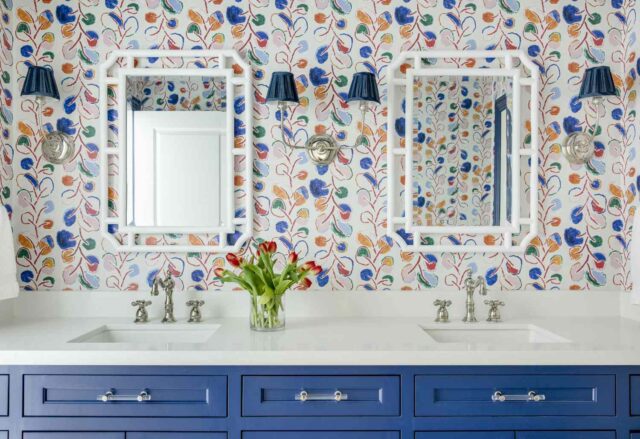
MEASURE UP
Choose a suitable wall to paper in your bathroom. Measure the height and width of the wall to determine the amount of wallpaper you’ll need. It’s a good idea to add a little extra to account for any mistakes or pattern matching.
PREPARE THE SURFACE
Ensure that the surface is clean, smooth, and dry before applying the wallpaper. Remove any existing wallpaper, paint, or debris. If the wall is uneven, use a filler to smooth out the surface and sand it down for a seamless finish.
SELECT YOUR WALLPAPER
Choose a wallpaper suitable for bathrooms, preferably one with a vinyl coating or a scrubbable finish. Bathroom wallpapers are designed to withstand humid and steamy conditions. Select a design that complements your bathroom’s style and color scheme.
APPLY THE ADHESIVE
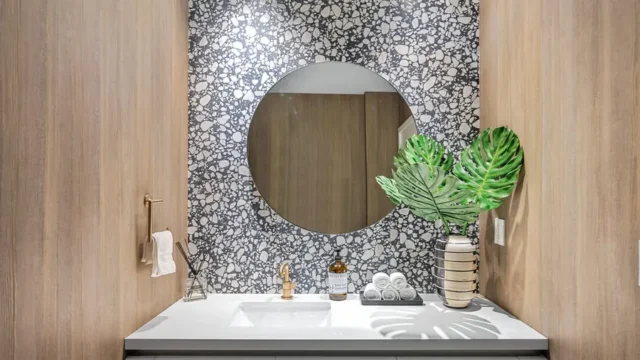
If you’re using traditional wallpaper, mix the adhesive according to the manufacturer’s instructions. Alternatively, if you’re using a “paste-the-wall” wallpaper, apply the adhesive directly to the wall. Start by applying the adhesive to the middle of the wall and work your way outwards.
HANG THE WALLPAPER
Carefully align the first strip of wallpaper with the edge of the wall, ensuring it is straight. Smooth out any air bubbles or wrinkles using a wallpaper brush or a clean, damp sponge. Continue hanging the remaining strips, matching the pattern if necessary.
TRIM THE EDGES
Once the wallpaper is applied, use a sharp knife or scissors to trim the excess wallpaper along the edges. Be careful not to damage the wall or the wallpaper.
SEAL THE EDGES
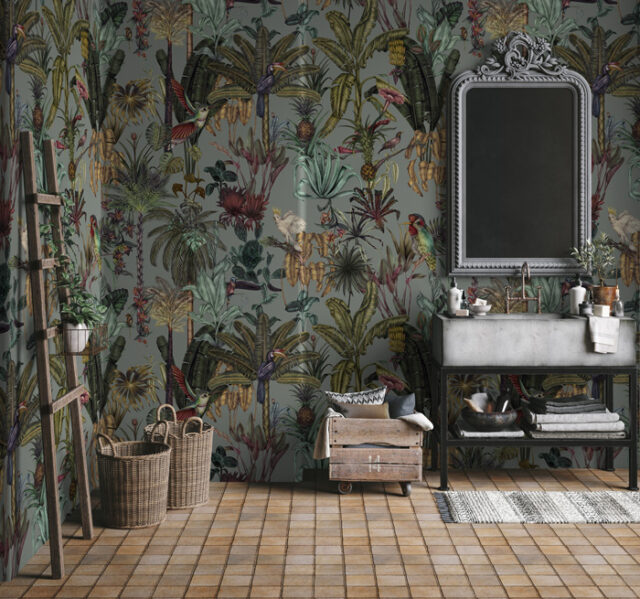
To ensure the wallpaper is well-adhered and protected from moisture, seal the edges with a waterproof sealant. This will help prevent peeling or lifting over time.
CLEAN UP
Clean up any excess adhesive or water from the wallpaper using a damp sponge or cloth. Wipe away any smudges or marks to leave a clean and polished finish.
Remember to follow the specific instructions provided by the wallpaper manufacturer for the best results. Proper ventilation and maintenance, such as using extractor fans and wiping down the wallpaper periodically, will help maintain its condition and longevity in a bathroom environment













